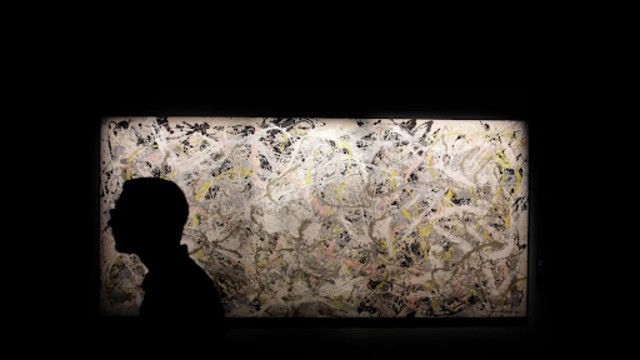
A visitor passes by Jackson Pollock's 1950 painting "N27" during a preview of the "Pollock and the School of NY" exhibition at Rome's Vittoriano Museum on October 9, 2018. AP Photo
A new study suggests that Jackson Pollock’s famous drip paintings may contain carefully placed images, challenging the belief that his work was purely abstract. The research, published by psychiatry professor Stephen M. Stahl, proposes that Pollock repeatedly embedded specific symbols into his paintings, possibly influenced by his bipolar disorder.
Stahl, who analyzed Pollock’s life and creative process, argues that the artist met the criteria for bipolar disorder. This condition has often been linked to increased creativity and enhanced cognitive abilities. According to the study, Pollock painted not in moments of depression or intoxication, as previously believed, but during periods of high energy and focus. This suggests a direct connection between his mental state and his unique artistic expression.
Pollock was historically diagnosed with various mental health conditions, including "alcoholic psychosis" and "schizophrenia-like disorder." However, Stahl believes that modern psychiatric assessments would classify him as bipolar. He suggests that Pollock’s ability to hide images within his chaotic brushstrokes could have been a product of both his mental state and his extraordinary spatial awareness, a trait found in some individuals with bipolar disorder.
Additionally, the study notes that Pollock underwent psychiatric treatment where he was exposed to Rorschach inkblot tests. These psychological tests encourage individuals to interpret abstract patterns, which may have influenced Pollock’s artistic process. Stahl suggests that Pollock may have subconsciously or deliberately embedded recurring symbols into his paintings, making them more than just random splashes of paint.
According to Stahl’s research, Pollock repeatedly included recognizable images such as bottles, self-portraits, monkeys, clowns, and elephants in his paintings.
“Seeing an image once in a drip painting could be random,” Stahl explains. “Seeing the same image twice in different paintings could be a coincidence. But when you see it three or more times, it’s unlikely to be accidental.”
This challenges the long-standing belief that Pollock’s work is entirely abstract and that any perceived imagery is purely based on viewer interpretation. Instead, Stahl’s findings suggest that Pollock’s paintings may have a structured and intentional visual language, adding new depth to the artist’s legacy.
Pollock’s art has always sparked debate, with critics arguing over whether his chaotic style was entirely random or guided by deeper meaning. Stahl’s research provides fresh insight, encouraging scholars and art lovers to view Pollock’s work through a different lens.
While the discussion continues, one thing is certain—Pollock’s paintings remain as intriguing as ever, inviting audiences to discover hidden stories beneath their complex layers of paint.















